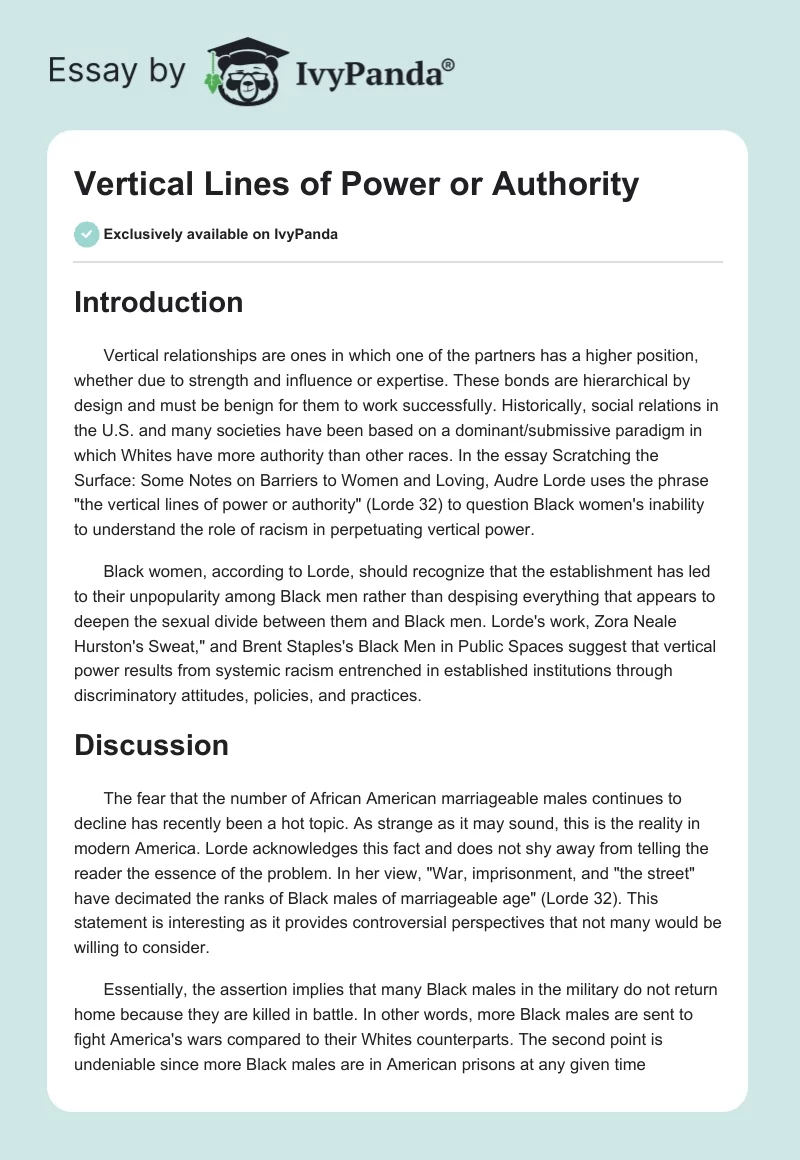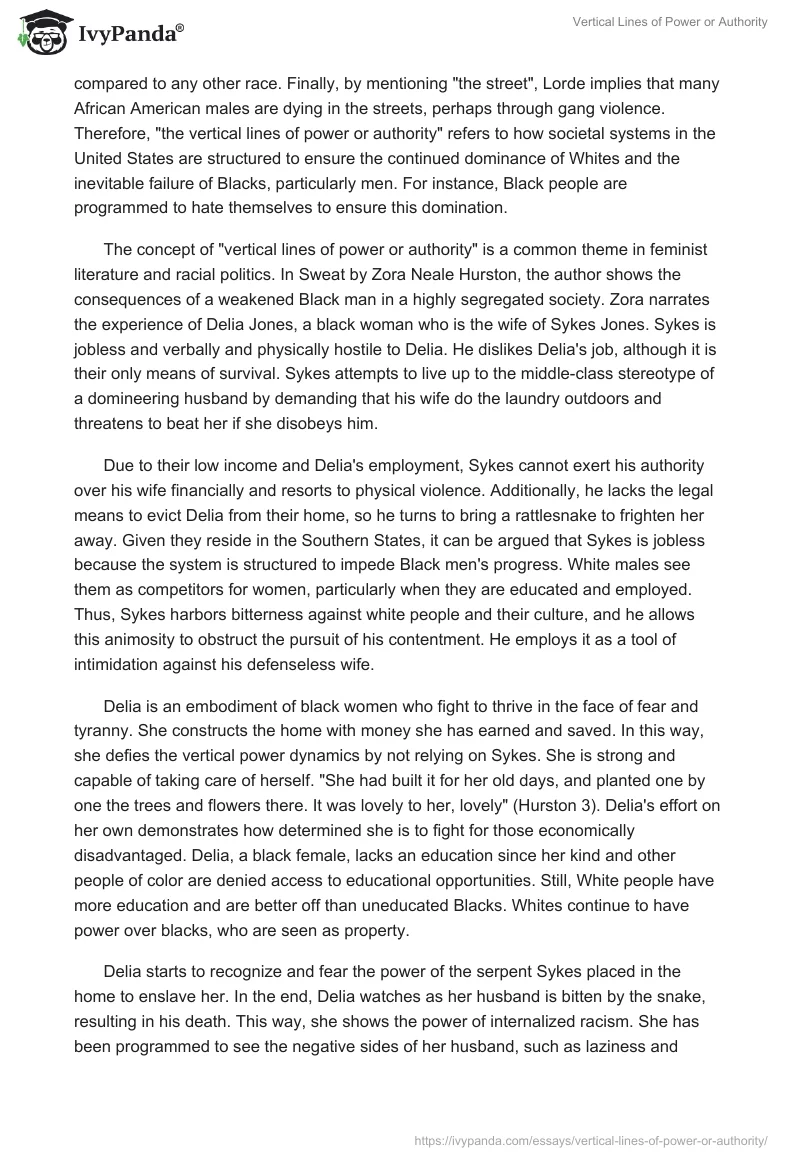Introduction
Vertical relationships are ones in which one of the partners has a higher position, whether due to strength and influence or expertise. These bonds are hierarchical by design and must be benign for them to work successfully. Historically, social relations in the U.S. and many societies have been based on a dominant/submissive paradigm in which Whites have more authority than other races. In the essay Scratching the Surface: Some Notes on Barriers to Women and Loving, Audre Lorde uses the phrase “the vertical lines of power or authority” (Lorde 32) to question Black women’s inability to understand the role of racism in perpetuating vertical power.
Black women, according to Lorde, should recognize that the establishment has led to their unpopularity among Black men rather than despising everything that appears to deepen the sexual divide between them and Black men. Lorde’s work, Zora Neale Hurston’s Sweat,” and Brent Staples’s Black Men in Public Spaces suggest that vertical power results from systemic racism entrenched in established institutions through discriminatory attitudes, policies, and practices.
Discussion
The fear that the number of African American marriageable males continues to decline has recently been a hot topic. As strange as it may sound, this is the reality in modern America. Lorde acknowledges this fact and does not shy away from telling the reader the essence of the problem. In her view, “War, imprisonment, and “the street” have decimated the ranks of Black males of marriageable age” (Lorde 32). This statement is interesting as it provides controversial perspectives that not many would be willing to consider.
Essentially, the assertion implies that many Black males in the military do not return home because they are killed in battle. In other words, more Black males are sent to fight America’s wars compared to their Whites counterparts. The second point is undeniable since more Black males are in American prisons at any given time compared to any other race. Finally, by mentioning “the street”, Lorde implies that many African American males are dying in the streets, perhaps through gang violence. Therefore, “the vertical lines of power or authority” refers to how societal systems in the United States are structured to ensure the continued dominance of Whites and the inevitable failure of Blacks, particularly men. For instance, Black people are programmed to hate themselves to ensure this domination.
The concept of “vertical lines of power or authority” is a common theme in feminist literature and racial politics. In Sweat by Zora Neale Hurston, the author shows the consequences of a weakened Black man in a highly segregated society. Zora narrates the experience of Delia Jones, a black woman who is the wife of Sykes Jones. Sykes is jobless and verbally and physically hostile to Delia. He dislikes Delia’s job, although it is their only means of survival. Sykes attempts to live up to the middle-class stereotype of a domineering husband by demanding that his wife do the laundry outdoors and threatens to beat her if she disobeys him.
Due to their low income and Delia’s employment, Sykes cannot exert his authority over his wife financially and resorts to physical violence. Additionally, he lacks the legal means to evict Delia from their home, so he turns to bring a rattlesnake to frighten her away. Given they reside in the Southern States, it can be argued that Sykes is jobless because the system is structured to impede Black men’s progress. White males see them as competitors for women, particularly when they are educated and employed. Thus, Sykes harbors bitterness against white people and their culture, and he allows this animosity to obstruct the pursuit of his contentment. He employs it as a tool of intimidation against his defenseless wife.
Delia is an embodiment of black women who fight to thrive in the face of fear and tyranny. She constructs the home with money she has earned and saved. In this way, she defies the vertical power dynamics by not relying on Sykes. She is strong and capable of taking care of herself. “She had built it for her old days, and planted one by one the trees and flowers there. It was lovely to her, lovely” (Hurston 3). Delia’s effort on her own demonstrates how determined she is to fight for those economically disadvantaged. Delia, a black female, lacks an education since her kind and other people of color are denied access to educational opportunities. Still, White people have more education and are better off than uneducated Blacks. Whites continue to have power over blacks, who are seen as property.
Delia starts to recognize and fear the power of the serpent Sykes placed in the home to enslave her. In the end, Delia watches as her husband is bitten by the snake, resulting in his death. This way, she shows the power of internalized racism. She has been programmed to see the negative sides of her husband, such as laziness and abusiveness, without considering how racism has contributed considerably to his behaviors.
Similarly, author Brent Staples claims in his essay Black Men and Public Space that he has been ethnically discriminated against numerous times. In other words, he has been unfairly labeled as a potential danger to the people in his immediate vicinity because he is Black. Staples emphasizes that regardless of how educated, diligent, or accomplished black males in the United States are, Whites have a negative view and judge them in a discriminatory manner. Staples provides instances of racism that persists in today’s culture, particularly among Whites, years after the Civil Rights movement. His credentials as a psychologist and writer and the details and parallels he provides all lend credence to his ideological argument.
Staples presents the audience with a tone that is submissive and obedient. This gives the perception that he would stop at nothing to ensure the comfort of those nearby. Furthermore, he strikes a tone of remorse to evoke sympathy from the reader. This can be seen in the statement, “I grew accustomed to but never comfortable with people who crossed to the other side of the street rather than pass me” (Staples 376). He recalls that when he frequently went on late-night strolls as a doctoral student, he became aware of how greatly his demeanor scared other people, notably Caucasian women. Although he recognizes that contemporary society has gotten more violent and unsafe, he is unhappy that black males, in particular, continue to be assessed and misunderstood only based on their looks.
Staples describes his first victim as a white lady strolling ahead in Hyde Park, a poor neighborhood in Chicago. He claims that when the lady noticed him behind her, she increased her pace, believing he was pursuing her (Staples 375). Due to his skin color and general appearance, the lady saw him as a threat. Instead of condemning the woman’s irrational suspicions as racist, Staples strives to show his innocence. He states: “I was stalking sleep, not defenseless wayfarers. As a softy who is scarcely able to take a knife to raw chicken—let alone hold one to a person’s throat—I was surprised, embarrassed, and dismayed all at once” (Staples 375).
He asserts that these occurrences are widespread, and he proceeds to provide examples that are moving to readers emotionally. Staples narrates how individuals lock their cars as he walks by, how an office staff contacts security and follows him because he is unfamiliar, and many other examples.
These cases above demonstrate conclusively that views about Staples and Black people like him are often inaccurate and unpleasant. Staples claims he has learned to cope with people’s misperceptions of him by whistling classical music whenever he feels the impulse to go for a nighttime stroll. He believes his whistling helps people perceive him as a sophisticated and compassionate guy rather than a jobless Black male preying on White people.
Conclusion
The concept of “vertical lines of power or authority” are the unspoken racist systems, policies, and attitudes that reduce Black people, especially males, to threats of social order while portraying Whites as the custodians or benchmarks of that order. Zora and Lorde believe that Black people can redraw these lines of power by being the shapers of their stories and identities and rejecting any degradation based on color, social status, and gender. Conversely, according to Staples, the easiest way to deal with racism in public places is to be tolerant and quiet about it. Although it is clear that acts of violence and hatred only serve to fuel more of the same, it is also clear that the problem has only become worse since his essay came out, and submission is not an effective solution.
Works Cited
Hurston, Zora Neale. Sweat. Rutgers University Press, 1997.
Lorde, Audre. “Scratching the surface: Some notes on barriers to women and loving.” The Black Scholar, vol. 9, no. 7, 1978, pp. 31-35.
Staples, Brent. “Black men and public space.” Harper’s Magazine, vol. 273, 1986, pp. 19-20.


